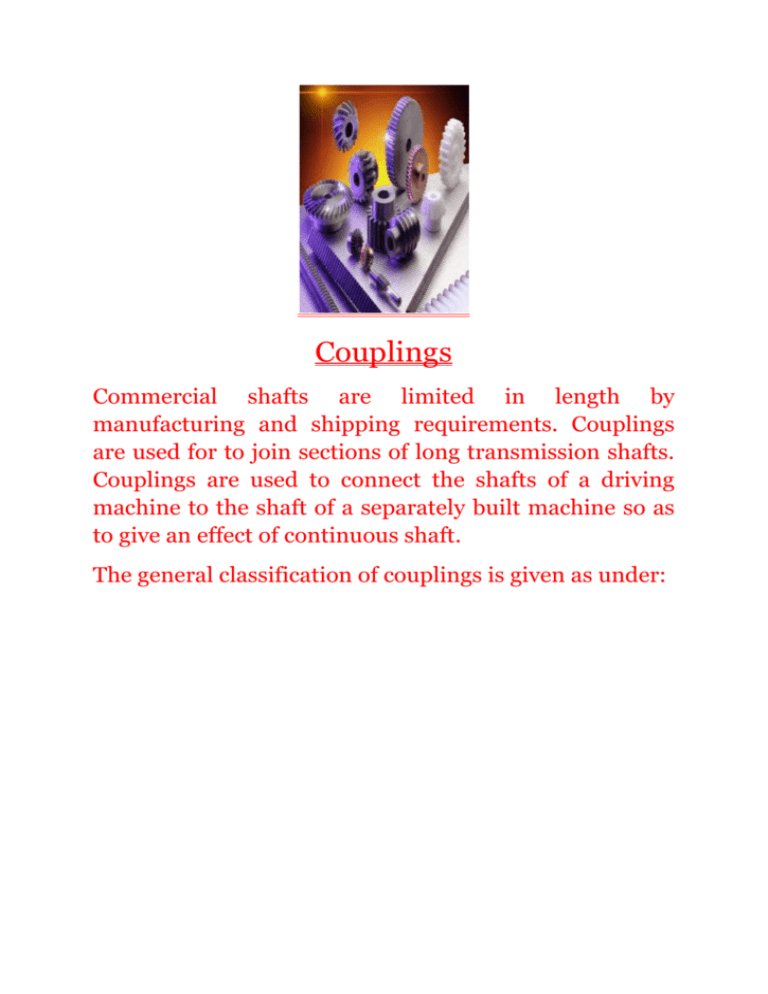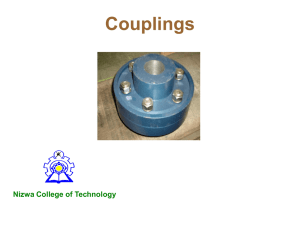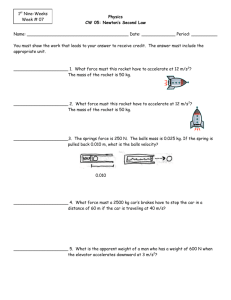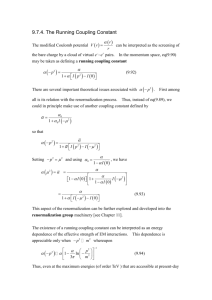gear couplings
advertisement

Couplings Commercial shafts are limited in length by manufacturing and shipping requirements. Couplings are used for to join sections of long transmission shafts. Couplings are used to connect the shafts of a driving machine to the shaft of a separately built machine so as to give an effect of continuous shaft. The general classification of couplings is given as under: Rigid coupling: 1)Muff coupling: As shown in figure the coupling consist of a sleeve normally made of cast iron ,in the form of hollow cylindrical which receives end of two shafts made to butt together inside the sleeve.The shafts are secured by means of a taper sunk key extending for the whole length of sleeve. Many times two separate keys are used to connect shafts and sleeve. The torque transmitted from one shaft to sleeve and then from sleeve to the other shaft. 2) Split muff coupling: This is a rigid type of coupling and modification of sleeve coupling. The sleeve is split into two approximate halves which are connected by through out bolts which are housed in recesses formed in the sleeve. The shafts are keyed together by using parallel key in the common key way. This type of coupling is used for heavy duty work. 3) Flange coupling: This type of coupling widely used for from medium to heavy duty work transmission. The flange coupling consist of two coupling halves keyed to the two shafts. These two halves are couples together by means of suitable number of bolts fitted in the holes through halves. As shown in figure when the bolts heads and nuts protrude beyond the flat surfaces of the flange , the coupling is called UNPROTECTED TYPE FLANGE COUPLING which renders the risk of accident of catching the clothes of operator . Figure shows the PROTECTED TYPE FLANGE COUPLING where each flange provided with a shroud or an annular projection which shelters the bolts heads and nuts. These projection may prevent catching of the clothes of operator . To ensure proper alignment of the coupling ,one of the flanges has a circular projection which fits in to a corresponding recesses in the other flanges. Flexible coupling: Flexible couplings are used to protect the driving and driven machines from effect of shocks, excessive stresses due to deflection and vibration which may arise from misalignment of shafts. 1)Bushed and pin type flange coupling: This is a modified form of protected type flange coupling. As shown in figure, this type of coupling has a cushioning effect due to flexible elements inserted in one of the flanges. The pins are rigidly fastened by nuts to one of the flanges and the enlarged diameters of the pin are covered with flexible material like leather or rubber bushings. The other flange has the holes corresponding to the size of bushings.The couplings are commonly used for directly connecting electric motor to a machine. The couplings permits axial movement and care of shock or slight alignment. 2)Oldham coupling: Oldham’s coupling is used in connecting two parallel shafts whose axes are at small distance apart. As shown in figure, the shafts to be connected have flanges rigidly fastened at their ends. The flanges have diametral slots at right angle to each other. The intermediate piece a circular disc has diametral projection on either side at right angle to each other and closely fit into the slots in the flanges. The rotation of drive shafts causes the rotation and sliding of circular disc which transmits motion and power to the driven shaft. ds as ds dadadas d 3)Universal coupling: This coupling is used to connect two shafts whose axes will intersect. The angle between the shafts axes may vary slightly during operation. As shown in figure ,the coupling of forks keyed to the ends of either shaft and they are pin joined to a centre block which has two arms at right angle to each other. This type of coupling is widely used in automobiles to connect propeller shaft and also in machine tools. Nylicon coupling Nylicon gear couplings are able to compensate for all types of shaft misalignment. They are easy to assemble and require no maintenance which ensures they provide a high quality service in the most inhospitable environments and require absolutely no maintenance. Type 600, are available in three sizes and are ideal for small power drives with bores sizes up to 55mm diameter and a basic rated torque up to 463 Nm. Thermosetting plastic sleeves provide non-conductive assemblies. Staggered internal teeth ensure uniform loading and an internal central buffer ring between the two hubs promotes axial location giving protection to the gear teeth. They compensate for all types of shaft misalignment and allow a small amount of end float. Nylicon couplings are easy to assemble and require no maintenance giving low cost reliable service under the most arduous conditions of weather, atmospheric pollution or humidity. Product Specification Bore Sizes: Up to 55 mm (2.2 in.) Unit Torque: Up to 463 Nm (98,200 lb.in.) Pin and Bush Couplings Pin and Bush couplings from are available in two options medium duty and heavy duty. They offer vastly improved torsional flexibility with a limited freedom of axial movement because of their series of rubber ‘conical section’ rings. Types 611, 612, 613, 614 are available with bore sizes up to 355mm diameter and a basic rated torque up to 188700 Nm. They accommodate all types of shaft misalignment met in normal operation, being a development of the old pin and bush design that it resembles in its simplicity and ease of dismantling. It differs fundamentally in the way its resilient material behaves by substituting the parallel bush with a series of rubber ‘conical section’ rings. This provides greatly improved torsional flexibility together with a limited freedom of axial movement of one connected shaft relative to the other. Two options are available, Medium Duty and Heavy Duty. Medium duty couplings (types 612 and 614) are identical to heavy-duty couplings (types 611 and 613) except that they are supplied with only half the standard number of pin and ring assemblies. This enables a useful cost saving to be made when the size of the coupling is determined by the shaft diameter rather than the coupling's torque capacity. Flexible Cone Ring couplings are also available with taper bushes (types 613 and 614) with bore sizes up to 125mm diameter, providing ease of assembly and dismantling together with flexibility to change shaft sizes by changing only the taper bushes. Product Specification Bore Sizes: Up to 355 mm (14 in.) Unit Torque: Up to 188,700 Nm (1,670,00 lb.in.) GEAR COUPLINGS Gear couplings are first and foremost dependable and provide quality efficient operation in high torque applications. The gear couplings dependability can be counted in the most testing of conditions. A torsionally rigid, lubricated design that offers high torque capacity, application versatility, and where high torque loads exist or shaft diameters exceed 100mm, the lowest initial cost. Available in 28 sizes, and all featuring triple-crowned teeth, David Brown gear couplings offer the industry leading torque ratings (over 8 million Nm) and the largest bore capacities (up to 1025 mm). Type GC02 & GC05 Continuous Sleeve Couplings - Features a one-piece, low profile sleeve encompassing the hubs. Economical and compact they are available in both close coupled and floating shaft models. Type G/GF32 Spacer Coupling - For pumps and compressor applications, provide ease of servicing ‘connected’ equipment. Type G/GF52 Floating Shaft Coupling - Used when distance between equipment is too great for spacer couplings. Two single engagement couplings with interconnecting shaft. Also available for vertical mounting. Type G/GF20 Close - Coupled Double Engagement Coupling - Design with 2 flex halves to accommodate both offset and angular misalignment. Also available for vertical mounting.





